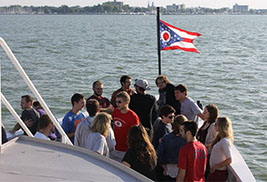Featured Article
Kent State Students Come Together to “Wreck the Flu”
This semester, the Honors Prevention and Control of Diseases class taught by Christopher Woolverton, Ph.D., was given a major project: To significantly increase student participation at the university’s annual flu clinic with a new awareness and marketing campaign.
read moreKent State, City of Sandusky Collaborate on Research Design Project
Posted Nov. 17, 2014 | Rachel Gill
Kent State University architecture students meet with
representatives of the city of Sandusky to ask questions
and gather pertinent information about the city for their
design project.
Kent State University architecture students partnered with Sandusky city officials for an opportunity to create new theoretical designs for some of downtown Sandusky’s vacant buildings and empty sites.
Sixty-four architecture majors, enrolled in a fourth-year senior design studio, were tasked with researching and developing a building program to rejuvenate parts of the downtown area.
“The assignment asked students to develop their own building program, which included hotels, museums, music venues, urban agriculture and lake research, and transform them into use for existing and vacant buildings or plots in Sandusky. The hope is that these projects can inspire and provide a vision for the community for what Sandusky could be,” says Joseph Ferut, an assistant professor of architecture and one of the design studio coordinators leading the class.
“Personally, this project has enriched my view of the city by showing the diverse components, colors and dynamism that composes city life,” says Timothy Ong, a Kent State architecture major. “The beauty of flourishing human activity that is potentially present in cities inspires and motivates the architect in me. The project has given me the room to dream and be visionary, to imagine Sandusky hustling and bustling with human life and activity. Practically, the ability to use Sandusky as a ‘sandbox’ to test concepts and ideas sharpens my ability to make design decisions pertaining to regeneration of cities.”
Along with Ferut, Kent State professors Lee Goodman, Charles Harker and Jack Hawk chose Sandusky as the location for this assignment because, “It has a rich urban fabric along the waterfront and is a typical Midwestern-size city that fell victim to suburban sprawl and loss of industrial jobs,” says Ferut. “It is one of many cities that deserve to be revitalized.”
Ferut explains the assignment’s economical and academic benefits for both the city of Sandusky and the students.
“Adaptive reuse is a significant strategy in sustainable design,” he says. “We want the students to understand the challenges and opportunities of using an existing structure. They are also required to implement sustainable design strategies such as daylighting, passive solar and cooling and renewable energy. The goal of designing the new building is to understand the differences and restrictions between existing and new. We want the students to take the new design as far as possible in terms of sustainable design and architectural form, while still responding to the architectural context.”
Just before the semester ends, the students will present their work to the general public and city officials in December at an open house. The Re-Vision Sandusky open house will feature student master plans and 120 design proposals at the Sandusky State Theater on Wednesday, Dec. 3, starting at 6 p.m.

As part of their site visit and analysis, Kent State
University architecture students took a tour of the
Sandusky Bay to get another perspective of the city.
The projects will not necessarily be implemented, but Sandusky officials may consider the ideas and incorporate them on certain projects in rejuvenating the city.
“I spoke to two men from Sandusky, a developer and a city official, and I got to share my ideas with them,” says Zachary Forney, a Kent State architecture major. “The best part was when they agreed with my designs because you don't typically get that many ‘I totally agree’ statements in design schools. It’s reassuring to hear the feedback from actual professionals on their projects.”
Many students enrolled in the senior design studio class have expressed how Kent State is the reason they have this opportunity to work with a real client.
“This opportunity was completely unexpected,” says Geno Catalano, a Kent State architecture major. “Typically, studio projects are completely hypothetical. Even when we started, I never would have guessed that what was once an exercise in adaptive reuse would become a chance for Sandusky to reinvent itself.”
“Kent State University strives to provide opportunities to take the step beyond traditional education and create a living learning environment,” says Christian Ford, Kent State architecture major. “We were able to meet with city planning representatives, the manager of the Sandusky Main Street Program, and most importantly, we were able to speak to the people. I hope that by the end of the project I am no longer simply designing architecture, but that I learn how to create an environment that has a positive and lasting impact on the users’ ways of life.”
For more information about Kent State’s College of Architecture and Environmental Design, visit http://www2.kent.edu/caed/.
